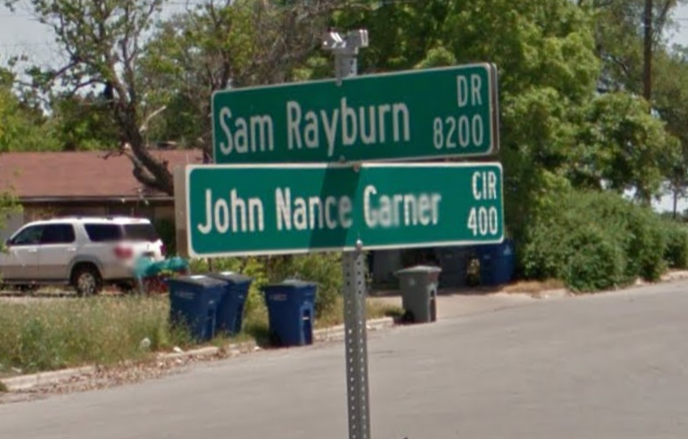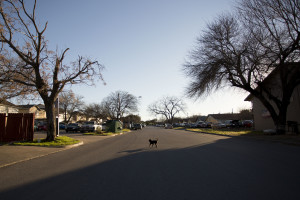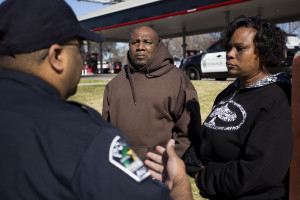
Antonio Mancinas, 68, leans against a tree in his front yard. He lives in a house with his wife at the end of Sam Rayburn Drive in the Rundberg neighborhood. Despite having spent roughly a quarter of a century on the street, he thinks back just a few years.
(Article by Audrey McGlinchy, http://www.austinmonitor.com/stories/2016/02/30765/)
“Just imagine,” Mancinas prompted in Spanish. “We were always afraid. It was dangerous, never knowing when there was going to be a shootout.”
Officers with the Austin Police Department describe Sam Rayburn Drive – named for a former U.S. House representative from Bonham, Texas – as once being one of the most dangerous streets in Austin.
“Used condoms and drug paraphernalia line the street,” wrote researchers with the University of Texas at Austin School of Social Work in a 2014 report. “Graffiti and gang insignia are sprayed on the buildings and fences, and some of the apartments are in significant disrepair. Drugs and prostitution are serious problems on Sam Rayburn and are often the catalyst for the violent crime that occurs here.”
But on a recent Friday afternoon, three kids under the age of 8 rode their bicycles up the street. A few yards ahead, older kids, most of them in middle school, took breaks from kicking around a soccer ball to pet a black, nameless puppy.
 “The biggest concern now is kids playing in the street,” said APD Senior Officer Rafael Kianes, who often walks the area. “You know, the cars (are) coming down the street, and (residents) don’t want the kids getting hit by the cars.”
“The biggest concern now is kids playing in the street,” said APD Senior Officer Rafael Kianes, who often walks the area. “You know, the cars (are) coming down the street, and (residents) don’t want the kids getting hit by the cars.”
In 2012, APD received a $1 million grant from the U.S. Department of Justice to reduce crime in the Rundberg area of North Austin. APD teamed up with UT researchers to decide how best to spend the money through law enforcement. One idea was to focus on several hot spots throughout the community – places where a large proportion of the area-wide crime was taking place. The researchers and police chose three: Sam Rayburn Drive, the Northgate neighborhood and the intersection of I-35 and Rundberg Lane.
On a recent Wednesday morning, Kianes and APD Officer Taber White walked along Rundberg Lane near I-35. Kianes approached mechanics milling around an auto body shop. He asked how things were going. The men said fine. Then, he pointed toward the west wall of the shop.
“I saw you guys covered up the graffiti over here,” Kianes said. “I know it can get tedious, but the more you take care of it, then the less they’re going to come back.”
APD’s efforts in Rundberg include a focus on community policing and, more specifically, mobile walking beats. Four days a week, Kianes and others walk one of the four hot spots (a fourth was added after the 2014 UT report) to check in with residents and those who frequent the area.
 “One of the things that we did when we first started addressing the area, we wanted to find out what the community feels about the area,” said Kianes. “So we surveyed the area. We spoke to people at bus stops, walking into the shops, talking to the owners of the area, the managers, the people who actually work the areas.”
“One of the things that we did when we first started addressing the area, we wanted to find out what the community feels about the area,” said Kianes. “So we surveyed the area. We spoke to people at bus stops, walking into the shops, talking to the owners of the area, the managers, the people who actually work the areas.”
From there, they targeted these specific concerns while establishing relationships with the people they spoke to. According to the latest data from UT, violent crime across Rundberg from April 2014 to August 2015 dropped by roughly 5 percent, while violent crime in the Sam Rayburn area during the same time period dropped by 44 percent.
But David Springer, a professor with the UT School of Social Work and lead researcher on the project, stressed that the decline cannot be attributed entirely to policing.
“We’re not able to pinpoint what the active ingredient is,” he said. “We have theories about what’s happening.” Springer said that he knows from research that community policing helps, but that another essential element is a feeling of community among neighbors – a job that Cecile Fandos, a community engagement coordinator with APD, has started to tackle.
“I was hired to help the officers because these guys are not going to be around as much as they are today,” Fandos said, hinting at the fact that the APD grant money ends in September 2016 (after a 10-month extension recently approved by City Council).
Fandos held a community meeting for Sam Rayburn residents in December, which she advertised by dropping off fliers at every doorstep. Only six residents showed up. One of them was Mancinas.
“The entire neighborhood has changed a lot,” he said. “We are very satisfied – glad that it is like this.”
Fandos’ plan is to get neighbors relying on one another more, to either alert one another of strangers walking around the neighborhood or to let neighbors know when crimes have happened. Fandos said this is something that did not happen in the past. The area is low-income, and the adults work several jobs, she said. Because of low rent prices, some residents live there for only a few months. Plus, it’s difficult to get to know your neighbors when leaving the house could be dangerous.
“When gangs used to shoot at each other across the street, I guess it didn’t invite friendly conversations,” she said, laughing.
Of course, nothing is foolproof. On Jan. 22, a woman was killed just at the end of Sam Rayburn, on East Powell Lane. Neighbors said it had been some time since a fatal shooting had taken place.
“That’s a good sign,” said Kianes. “It’s not good that someone dies. But it’s a good sign that people are concerned. This is not the normal thing that happens here.”
This story was produced as part of our reporting partnership with KUT.
An earlier version of this story identified the victim of a shooting on Jan. 22 as a man. While that’s what the Austin Police Department release states, the deceased identified as a woman. We regret the mistake.
Read more at: http://www.austinmonitor.com/stories/2016/02/30765/

